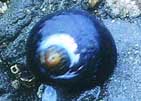We can make a strong case that natural selection is operating, even if the details of that selection are not immediately apparent.

For example, on rocky shores, animals have ranges that form clear spatial patterns. Some species live only in deep water, and some only live much higher up the shore. A snail common on California shores (Tegula funebralis, at right) can be found in both ranges. In Southern California, Tegula live high up on the shore, while in Northern California, they live in deeper water.
Could natural selection explain this pattern? Researcher Michael Fawcett thought so and formulated a hypothesis to test. He found that predators, such as octopuses, starfish, and crabs, were more abundant in southern California than in northern California. Perhaps intense predation in the south selected for snails that lived higher up the shore, out of reach of many predators. In the north, selection might not have been as strong, so the snails were not selected to live high on the shore.
Fawcett tested this hypothesis by transplanting snails. He took northern and southern snails, released them in deep water and watched what happened. If predators were around, all the snails high-tailed it towards higher ground (snails can probably sense the chemicals exuded by predators). But southern snails moved further up the shore faster than northern snails. Because the northern snails were slower and didn’t move high enough, they were more likely to be eaten by predators.
What did this experiment show?
- There is an innate difference between southern and northern snails (i.e., some difference that is not merely a function of being on a southern or northern shore). This difference is probably genetic (but we would need to do more experiments to be absolutely sure).
- This difference can lead to differential survival. If predation is intense, snails that move higher faster are more likely to survive.
These results suggest that natural selection has occurred, altering the predator escape trait. Remember, all you need is
- Variation: There is variation in a trait between and within populations.
- Heredity: The variation probably has a genetic basis.
- Differential reproduction: The variants of the trait have different probabilities of surviving to reproduction.
These three features define natural selection. Without them, natural selection does not happen.
Get more examples of how biologists study natural selection:
- Sex, speciation, and fishy physics, a news brief with discussion questions.
- Musseling in on evolution, a news brief with discussion questions.
Teach your students about natural selection:
- Clipbirds, a classroom activity for grades 6-12.
- Breeding bunnies, a classroom activity for grades 9-12.
Find additional lessons, activities, videos, and articles that focus on natural selection.

